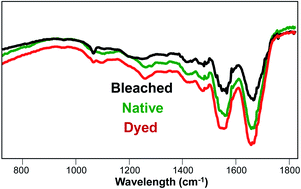Infrared analysis of hair dyeing and bleaching history†
Abstract
Forensic examination of hair is commonly performed to trace its origin and make a connection between a suspect and a crime scene. Such examination is based on subjective microscopic analysis of hair. During the last decade, several spectroscopic approaches have been proposed to make forensic analysis of hair more robust and reliable. Surface-enhanced Raman and attenuated total internal reflection infrared spectroscopies allowed for detection and identification of dyes directly on hair and even differentiation between commercial brands of those colorants. However, these is a question that remains unanswered: can artificial dyes be detected on bleached hair or bleaching can be used to fully erase information about hair coloring? In this study, we report experimental results that provide a clear answer to this question. We show that infrared analysis can be used to differentiate between undyed bleached hair and hair that was colored with both permanent and semi-permanent dyes prior to bleaching. We also show that IR analysis can be used to distinguish between undyed unbleached and undyed bleached hair. We demonstrate that in combination with multivariate statistical analysis, IR analysis can be used to distinguish with 96–100% accuracy between those hair classes.



 Please wait while we load your content...
Please wait while we load your content...